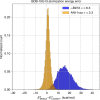Approaching coupled cluster accuracy with a general-purpose neural network potential through transfer learning
- PMID: 31263102
- PMCID: PMC6602931
- DOI: 10.1038/s41467-019-10827-4
Approaching coupled cluster accuracy with a general-purpose neural network potential through transfer learning
Abstract
Computational modeling of chemical and biological systems at atomic resolution is a crucial tool in the chemist's toolset. The use of computer simulations requires a balance between cost and accuracy: quantum-mechanical methods provide high accuracy but are computationally expensive and scale poorly to large systems, while classical force fields are cheap and scalable, but lack transferability to new systems. Machine learning can be used to achieve the best of both approaches. Here we train a general-purpose neural network potential (ANI-1ccx) that approaches CCSD(T)/CBS accuracy on benchmarks for reaction thermochemistry, isomerization, and drug-like molecular torsions. This is achieved by training a network to DFT data then using transfer learning techniques to retrain on a dataset of gold standard QM calculations (CCSD(T)/CBS) that optimally spans chemical space. The resulting potential is broadly applicable to materials science, biology, and chemistry, and billions of times faster than CCSD(T)/CBS calculations.
Conflict of interest statement
The authors declare no competing interests.
Figures




References
-
- Ramsay OB. Serendipity: accidental discoveries in science (Roberts, R. M.) J. Chem. Educ. 2009;67:A311. doi: 10.1021/ed067pA311.1. - DOI
-
- Berson JA. Discoveries missed, discoveries made: creativity, influence, and fame in chemistry. Tetrahedron. 1992;48:3–17. doi: 10.1016/S0040-4020(01)80574-3. - DOI
-
- Kohn W. Nobel Lecture: electronic structure of matter—wave functions and density functionals. Rev. Mod. Phys. 1999;71:1253–1266. doi: 10.1103/RevModPhys.71.1253. - DOI
-
- Purvis GD, Bartlett RJ. A full coupled-cluster singles and doubles model: the inclusion of disconnected triples. J. Chem. Phys. 1982;76:1910–1918. doi: 10.1063/1.443164. - DOI
Publication types
MeSH terms
Substances
Grants and funding
- 1338192/National Science Foundation (NSF)/International
- CHE-1802831/National Science Foundation (NSF)/International
- CHE-1802789/National Science Foundation (NSF)/International
- N00014-16-1-2311/United States Department of Defense | United States Navy | Office of Naval Research (ONR)/International
- 110088/NSF | Directorate for Mathematical & Physical Sciences | Division of Materials Research (DMR)/International
LinkOut - more resources
Full Text Sources

